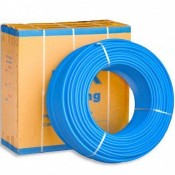Q: What’s the difference between oxygen barrier and non-barrier PEX?
A: Oxygen barrier type PEX pipe has an external polymer coating called EVOH or “oxygen diffusion barrier” and it’s the type used for all standard closed loop heating applications, including floor heating, baseboard/radiator heating and snow melting. Non-barrier PEX has no additional coatings and is the type used for hot and cold water plumbing applications, as well as for open-loop heating systems.
Q: What’s the difference between open and closed loop systems?
A: A closed loop heating system contains water which circulates in a closed loop without mixing with fresh water or being exposed to the atmosphere. In a closed loop system, water is heated by a boiler (or similar), pumped to the floor heating system (or baseboards/radiators), then returns back to the boiler and the cycle repeats. Such systems often contain cast iron parts (boilers’ heating elements, pumps, etc.) and therefore would require PEX with O2 barrier.
An open loop heating system often utilizes the domestic hot water from a water heater or a storage tank and therefore has high oxygen content, which would require that the system’s components are either stainless steel, bronze or brass. Such systems do not require an O2 barrier and can use the non-barrier type PEX.
Q: Can I use PEX for solar applications?
A: No. Temperatures in solar systems often far exceed the 180°F rating of the PEX tube and would require either copper or corrugated steel pipes.
Q: Which size PEX tubing should I use?
A: For residential radiant floor heat installations, 1/2" PEX tubing is most common. For commercial, sizes up to 3/4" (and even 1" in some cases) can be used depending on the project size. For baseboards, 5/8" or 3/4" PEX are recommended, although very small baseboards can be fed with 1/2" PEX lines. For cast iron and aluminum radiators, 3/4" PEX is a standard size.
In small to mid size residential plumbing 3/4" PEX is used for mains and 1/2" for feeding water to the fixtures. In larger size homes, 1" size is sometimes used for main water lines.
Q: What’s the recommended spacing of PEX in a floor heating system?
A: When attaching to the subfloor between the joists with 16" OC spacing, 1/2" PEX is spaced at ~8" apart. For most other installations, including thin slabs over plywood, basements and structural (wire mesh or rebar reinforced) concrete slabs, the spacing is usually 10-12". The numbers above are typical for well insulated structures and may vary depending on local climate and temperature of water in the heating system.
Q: Does PEX color make a difference?
A: No. Tubing comes in different colors to help distinguish between hot and cold water lines with red and blue colored pipes respectively.
Q: Can I use Everhot PEX pipe with a different brand tools and fittings?
A: Yes, Everhot PEX tubing is compatible with majority of the tool and fitting brands sold in the US, including Watts, Viega, Nibco, Zurn and many others. See “Connection Systems” tab for compatibility details.
Q: Can PEX pipe be used for installation of an outdoor wood boiler or furnace?
A: Yes. 1" oxygen barrier PEX is most common for the job. For non-pressurized boilers, PEX piping without O2 barrier can be used.




